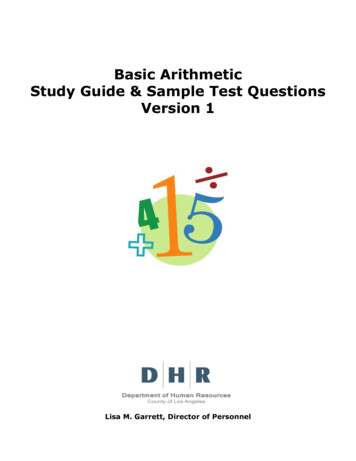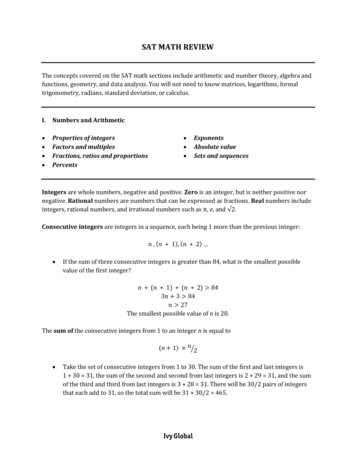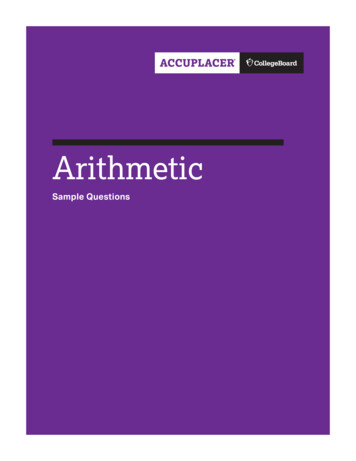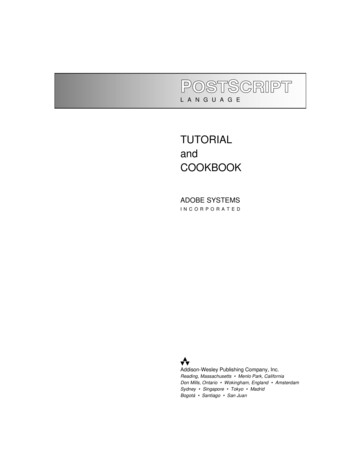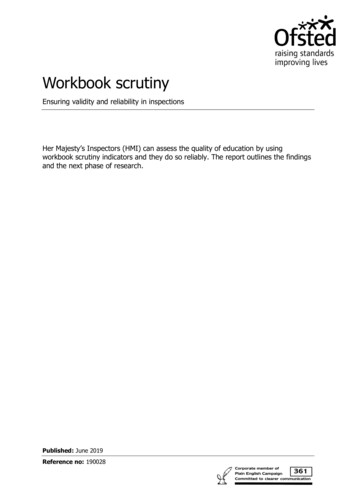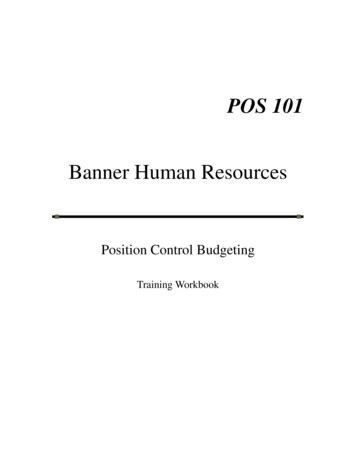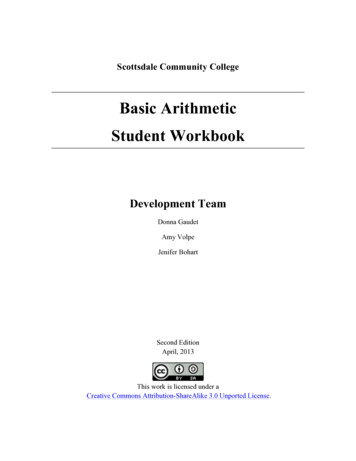
Transcription
Scottsdale Community CollegeBasic ArithmeticStudent WorkbookDevelopment TeamDonna GaudetAmy VolpeJenifer BohartSecond EditionApril, 2013This work is licensed under aCreative Commons Attribution-ShareAlike 3.0 Unported License.
ii
A NOTE ABOUT THIS WORKBOOKThis workbook was created through the efforts of three instructors at ScottsdaleCommunity College in Scottsdale, Arizona. Any individual may download and utilize adigital copy of this workbook for free. The Creative Commons licensing of this textallows others to freely use, modify, or remix any of the information presented here.Contact Donna Gaudet at dgaudet.scc@gmail.com if you are an instructor that wishes toteach with these materials or adapt and edit them for teaching.This workbook does not contain beautiful graphics, hundreds of problems or 4-colorprinting. Those things are wonderful to have but also very expensive. This workbookdoes have lessons that were carefully and thoughtfully crafted to lead students on a pathto understanding numbers and arithmetic.As you work through the text, you may find errors. If you do, please contact DonnaGaudet at the email address above and provide specific information about the error andwhere it is located. The information presented in the text is a work in progress and willevolve with the input of students and other users. We look forward to your feedback!iii
WORKOOK & SUPPORTING COMPONENTSThis workbook is designed to lead students through a basic understanding of numbersand arithmetic. The included curriculum is broken into twelve lessons (see Table ofContents page for lesson titles). Each lesson includes the following components:MINILESSON The MiniLesson is the main instructional component for each lesson.Ideas are introduced with practical situations.Example problems (marked with a star) are to be completed by watching videolinks and taking notes/writing down the problem as written by the instructor.Video links can be found at http://sccmath.wordpress.com or may be locatedwithin the Online Homework Assessment System.You Try problems help reinforce lesson concepts and should be worked in theorder they appear showing as much work as possible. Answers can be checked inAppendix A.PRACTICE PROBLEMS These problems can be found at the end of each lesson. If you are workingthrough this material on your own, the recommendation is to work all thoseproblems. If you are using this material as part of a formal class, your instructorwill provide guidance on which problems to complete. Your instructor will alsoprovide information on accessing answers/solutions for these problems.ASSESS YOUR LEARNING The last part of each lesson is a short assessment. If you are working through thismaterial on your own, use these assessments to test your understanding of thelesson concepts. Take the assessments without the use of the book or your notesand then check your answers. If you are using this material as part of a formalclass, your instructor will provide guidance on which problems to complete. Yourinstructor will also provide information on accessing answers/solutions for theseproblems.ONLINE HOMEWORK ASSESSMENT SYSTEM If you are using these materials as part of a formal class and your class utilizes anonline homework/assessment system, your instructor will provide information asto how to access and use that system in conjunction with this workbook.iv
TABLE OF 1- 19LESSON2- SSON.37LESSON3- SSESSYOURLEARNING.69LESSON5- ‐DECIMALS.71MINILESSON.73LESSON5- .85LESSON6- TIOS,RATES,&PROPORTIONS.105MINILESSON.107LESSON7- G.119LESSON8- ‐STATISTICS.121MINILESSON.123LESSON8- LESSON9- SWERSTOYOU- ‐TRYPROBLEMS.223BASICARITHMETIC- ‐CUMULATIVEREVIEW.227BASICARITHMETIC- ‐CUMULATIVEREVIEW- ‐Answers.237v
vi
Basic ArithmeticLesson 1 – Whole NumbersLESSON 1 – WHOLE NUMBERSINTRODUCTIONWe will begin our study of Basic Arithmetic by learning about whole numbers. Wholenumbers are the numbers used most often for counting and computation in everyday life.The table below shows the specific whole-number related objectives that are theachievement goal for this lesson. Read through them carefully now to gain initialexposure to the terms and concept names for the lesson. Refer back to the list at the endof the lesson to see if you can perform each objective.Lesson ObjectiveIdentify the place value of a digit or digits in a given number.Read and write whole numbers.Round whole numbers to a given place.Rewrite an exponential expression in factored form.Compute numerical expressions using exponents.Use correct order of operations to evaluate numerical expressions.Solve whole number applications with a problem-solving processRelated Examples1, YT72, YT43, YT5, YT6812, 13, YT149, 10, 11, YT1516, YT17KEY TERMSThe key terms listed below will help you keep track of important mathematical words andphrases that are part of this lesson. Look for these words and circle or highlight themalong with their definition or explanation as you work through the MiniLesson. Whole NumbersNumber LinePlace ValueRound Whole NumbersExponentPowerFactorFactored FormMathematical OperationsOrder of Operations (PEMDAS)Solution Work FlowComplete SolutionDisjointed SolutionProblem Solving Process1
Basic ArithmeticLesson 1 – Whole NumbersLESSON CHECKLISTUse this page to track required components for your class and your progress on each one.ComponentRequired?Y or TestPracticeProblemsLessonAssessment2DueScore
Basic ArithmeticLesson 1 – Whole NumbersMINILESSONWHOLE NUMBERS, PLACE VALUE, AND ROUNDINGWhole numbers are often referred to as “the counting numbers plus the number 0”. Thefirst few whole numbers are written as: 0, 1, 2, 3, 4, 5, 6, 7, We can place a representative set of these on a number line as follows:Note that the arrows on the number line indicate that the numbers continue in bothdirections. We will learn in Lesson 12 about numbers to the left of 0!We read whole numbers from left to right. To do this correctly, we need to know theplace value of each digit in the number. The table below illustrates place values throughthe Billions place. You can use this table to help you properly identify number names.Example 1: Place each number in the chart above. What place value does the digit “0”occupy in each number?a. 25,032b. 105,243c. 12, 340,412Example 2: Write each whole number below in words.a. 275,345,201b. 502,0133
Basic ArithmeticLesson 1 – Whole NumbersTo round a number means to approximate that number by replacing it with anothernumber that is “close” in value. Rounding is often used when estimating. For example, ifI wanted to add 41 and 37, I could round each number to the nearest ten (40 and 40) thenadd to estimate the sum at 80.When rounding, the analogy of a road may help you decide which number you are closerto. See the image below. The numbers 43, 45, and 46 are all rounded to the nearest tensplace. Note that a number in the middle of the “road” is rounded up.Example 3:a. Round 40,963 to the nearest tens place.b. Round 40,963 to the nearest hundreds place.c. Round 40,963 to the nearest thousandd. Round 40,963 to the nearest ten thousandYOU TRY4. Write the number 12,304,652 using words.5. Round 12,304,652 to the nearest million.6. Round 12,304,652 to the nearest hundred.7. What place does the digit 3 occupy in the number 12,304,652?4
Basic ArithmeticLesson 1 – Whole NumbersEXPONENTSExponents are also called powers and indicate repeated multiplication.Worked Example 8: 34 3 3 3 3 9 3 3 27 3 81Note: There are 4 factors of 3 in the exponential expression 34. When we write34 3 3 3 3 , we have written 34 in factored form.On your calculator, you can compute exponents a couple of ways as follows:a) If you are raising a number to the second power (for example 42), look foran x2 key on your calculator. Then, enter 4x2 or ENTER and you shouldget 16.b) If you are raising a number to a power other than 2, look for a carrot key ( ).For example 45 4 5 and you should get 1024. Note that you can also usethe ( ) key even when raising to the 2nd power (also called “squaring”).ORDER of OPERATIONSAddition, subtraction, multiplication, and division are called mathematical operations.When presented with more than one of these in an expression, we need to know whichone to address first. The chart below will help us.PSimplify items inside Parenthesis ( ), brackets [ ] or other grouping symbols first.ESimplify items that are raised to powers (Exponents)MPerform Multiplication and Division next(as they appear from Left to Right)DAPerform Addition and Subtraction on what is left.(as they appear from Left to Right)SExample 9: Evaluate 8 5 2Example 10: Evaluate 24 (4 2)Example 11: Evaluate 20 – (8 – 2) 3 4Example 12: Evaluate 10 32 8 2 Example 13: Evaluate 7 2 10 4225
Basic ArithmeticLesson 1 – Whole NumbersWORK FLOW AND WRITING SOLUTIONSWhen you begin to do work that requires more than a single computation, the steps thatyou present in your solution should be equivalent. Try to provide a complete solution asseen in the videos as opposed to a series of disjointed computations. See the examplesbelow.COMPLETE SOLUTION – shows all work in neat, coherent, equivalent stepsDISJOINTED SOLUTION – shows work but steps are not equivalent, information is leftout of the solution processMATHEMATICS AND WRITINGWhen faced with a mathematical problem, you really have two goals. The first is to workthe problem correctly and the second is to present a complete solution that can be readand understood by yourself and by others. Just because you know how to do a problemtoday does not mean that you will quickly remember how to do it when you look back onit in the future. Strive to present complete solutions following the examples andpresentations that you see in the media links. Mathematics is really learned throughwriting. The better your solutions the more you will learn and retain. As you moveforward in mathematics, learning to write a good solution may help you solve problemsyou would not have been able to otherwise.A NOTE ON NOTATIONIn mathematics, the operation of multiplication can be communicated a number ofdifferent ways. Each of the notations below means “3 times 5”:3 x 5 (3)(5) 3(5) 3 56
Basic ArithmeticLesson 1 – Whole NumbersYOU TRY14. Evaluate by hand, showing all possible steps. Try to use good solution flow asdiscussed on the previous page.2 4 8 (2 3) 2Insert check mark to verify same result via calculator:15. Evaluate by hand, showing all possible steps. Try to use good solution flow asdiscussed on the previous page.9 3 75 2Insert check mark to verify same result via calculator:7
Basic ArithmeticLesson 1 – Whole NumbersAPPLICATIONS WITH WHOLE NUMBERS“Applications” ask you to use math to solve real-world problems. To solve theseproblems effectively, begin by identifying the information provided in the problem(GIVEN) and determine what end result you are looking for (GOAL). The GIVENshould help you write mathematics that will lead you to your GOAL. Once you have aresult, CHECK that result for accuracy then present your final answer in a COMPLETESENTENCEEven if the math seems easy to you in this application, practice writing all the steps, asthe process will help you with more difficult problems.Example 16: Amy drives to Costco to buy supplies for an upcoming event. She isresponsible for providing breakfast to a large group of Boy Scouts the next weekend.Hashed browns are on her list of supplies to purchase and she needs to buy enough toserve 100 people. The hashed browns are sold in packs of 8 boxes and each box in thepack will serve 4 people. A) How many packs should she buy minimum and B) Howmany people will she be able to serve with this purchase?GIVEN: [Write down the information that is provided in the problem. Diagrams can behelpful as well.]GOAL: [Write down what it is you are asked to find. This helps focus your efforts.]MATH WORK: [Show your math work to set up and solve the problem.]CHECK: [Is your answer reasonable? Does it seem to fit the problem? A check may notalways be appropriate mathematically but you should always look to see if your resultmakes sense in terms of the goal.]FINAL RESULT AS A COMPLETE SENTENCE: [Address the GOAL using acomplete sentence.]8
Basic ArithmeticLesson 1 – Whole NumbersYOU TRY17. You join a local center in your community that has a swimming pool and a group thatswims laps each week. The initial enrollment fee is 105 and the group membership is 44 a month. What are your dues for the first year of membership?GIVEN:GOAL:MATH WORK:CHECK:FINAL RESULT AS A COMPLETE SENTENCE:9
Basic ArithmeticLesson 1 – Whole Numbers10
Basic ArithmeticLesson 1 – Whole NumbersLESSON 1 - PRACTICE PROBLEMS1. Identify the place value of the digit “6” in each of the following numbers.a. 356,230b. 6,456,678c. 300,560d. 461,345,567e. 6,540,345,234f. 405,978,1062. Write each of the following whole numbers in words.a. 356,230b. 6,456,678c. 300,560d. 461,345,567e. 6,540,345,234f. 405,978,1063. Write each of the following in “factored” form and then compute the final result.a. 23b. 35c. 42d. 54e. 63f. 7211
Basic ArithmeticLesson 1 – Whole Numbers4. Evaluate each of the following using correct order of operations. Show allpossible steps and check your work using your calculator.a. 7 2(5 – 3)b. 4 12 3 2 4 2c. 32 6 – 5d. 51 – (47 – 2) 5 3e. 15 [3(8 – 22) – 6]f.4 2 63 8 22 15. Solve each of the following applications showing as much work as possible. Usethe problem-solving process described in the lesson to write your solution.a. Mark deposited 450, 312, 125, and 432 in his bank account thismonth. He also made deductions of 205 and 123. If his balance at thebeginning of the month was 1233, what was his balance at the end of themonth?12
Basic ArithmeticLesson 1 – Whole Numbersb. Jenelle financed a 2012 Chevy Camaro on 60-month terms for 673 permonth. If the MSRP on the car was 35,000 and she put no money down,how much over the MSRP did she end up paying?c. In the winter, the farmer’s market sees an average of 1516 visitors eachSunday. In the summer, they see an average of 4278 visitors each Sunday.How many more visits are there in the summer than in the winter (onaverage)?d. There are 12 reams of paper in a given box. How many reams are there in25 boxes?13
Basic ArithmeticLesson 1 – Whole Numbers14
Basic ArithmeticLesson 1 – Whole NumbersLESSON 1 – ASSESS YOUR LEARNINGWork the following to assess your learning of the concepts in this lesson. Try to writecomplete solutions and show as much work as you can.1. Identify the place value of the digit “7” in the following number.11,261,9712. Identify the place value of the digit “4” in the following number.5,241,9663. Write the following number in words.12,089,5264. Write the following number in words.8,002,079,1235. Write the number in “factored” form and then compute the final result426. Evaluate the following using correct order of operations. Show all possible steps andcheck your work using your calculator.9 (7 4) 32 6 515
Basic ArithmeticLesson 1 – Whole Numbers7. Evaluate the following using correct order of operations. Show all possible steps andcheck your work using your calculator.12 4 7 14 4 3 47 28. Solve the following problem using the 5-step problem solving process. Include thecategories: Given, Goal, Math work, Check and Final result as a complete sentence.Amy deposited 325, 473, 224 and 653 into her checking account one month. Shepaid bills in the amounts of 54, 127, 96 and 685. How much money does she haveleft over after paying her bills?9. Solve the following problem using the 5-step problem solving process. Include thecategories: Given, Goal, Math work, Check and Final result as a complete sentence.Tally bought dog food for an animal rescue shelter. She bought 6 bags that weighed 25pounds each and 19 bags that weighed 7 pounds each. How many pounds of dog fooddid she buy?16
Basic ArithmeticLesson 2 – Introduction to FractionsLESSON 2 – INTRODUCTION TO FRACTIONSINTRODUCTIONIn this lesson, we will work again with factors and also introduce the concepts of primeand composite numbers. We will then begin working with fractions and the concept of“parts of a whole”.The table below shows the specific objectives that are the achievement goal for thislesson. Read through them carefully now to gain initial exposure to the terms and conceptnames for the lesson. Refer back to the list at the end of the lesson to see if you canperform each objective.Lesson ObjectiveFind all factors of a number.Write the prime factorization for a composite number.Find the LCM (Least Common Multiple) of two numbers.Recognize a fraction as part of a whole.Identify fractions represented by shading.Write mixed numbers as improper fractions.Write improper fractions as mixed numbers.Find equivalent fractions.Write fractions in simplest form.Compare fractions.Graph fractions on a number line.Simplify fractions that have a “1” in the numerator or denominator.Simplify fractions that have a “0” in the numerator or denominator.Solve applications with fractions.Related Examples1, YT42, YT53669, YT10, YT1411, YT12, YT1315, 16, YT1817, YT 18, YT192021222223, YT24KEY TERMSThe key terms listed below will help you keep track of important mathematical words andphrases that are part of this lesson. Look for these words and circle or highlight themalong with their definition or explanation as you work through the MiniLesson. FactorsPrime NumberComposite NumberPrime FactorizationExponential FormFactored FormLeast Common Multiple (LCM)Fraction 17NumeratorDenominatorProper FractionImproper FractionMixed NumberQuotientRemainder
Basic ArithmeticLesson 2 – Introduction to FractionsLESSON CHECKLISTUse this page to track required components for your class and your progress on each one.ComponentRequired?Y or TestPracticeProblemsLessonAssessment18DueScore
Basic ArithmeticLesson 2 – Introduction to FractionsMINILESSONFACTORSThe factors of a number divide the number evenly (with remainder zero).Example 1: Find all factors of 24.PRIME FACTORIZATIONA prime number is a whole number that has only itself and 1 as factors.(Example: 2, 3, 5, 7, 13, 29, etc )A composite number is a whole number that is not prime (i.e. has factors other than itselfand 1). Every composite number can be written as a product of prime factors. Thisproduct is called the prime factorization.Example 2: Find the prime factorization of each of the following. Write the final result inexponential form and factored form.72600LEAST COMMON MULTIPLE (LCM)Example 3: The LCM of two numbers is the smallest number for which both numbersare factors. For example, the LCM of 2 and 4 is 4. The LCM of 3 and 5 is 15. Find theLCM of 8 and 10:Multiples of 8 are:Multiples of 10 are:Some common multiples of 8 and 10 are:The LEAST COMMON MULTIPLE of 8 and 10 is19
Basic ArithmeticLesson 2 – Introduction to FractionsYOU TRY4. List the factors of 18.5. Find the prime factorization of 270.FRACTIONSSuppose I buy a candy bar to split with two of my friends. What number could we use todiscuss how much of the bar each of us would get? Well, if we have 1 bar and it is split11into 3 equal pieces, then we would say that each person gets of the bar. The number33is called a fraction because we use it to represent part (one part) of a whole (3 pieces).1can be represented by the shaded part in each of the following diagrams.3Notice that in each diagram, the whole is a different shape or set of shapes but the use of1the fraction still applies.3The fractionExample 6: Identify the fraction represented by the shaded part of each figure.YOU TRY7. Draw two different figures or sets of figures that are203shaded.4
Basic ArithmeticLesson 2 – Introduction to FractionsVocabulary of fractions: The top number in a fraction is called the numerator. The bottom number in a fraction is called the denominator. Fractions for which the top number is smaller than the bottom are called properfractions. Fractions whose numerator is larger than the denominator are called improperfractions and can be written as what are called mixed numbers.Example 8: Identify the fraction represented by the shaded part of each figure.Example 9: Express as an improper fraction.2141213YOU TRY10. Write the steps to convert a mixed number to an improper fraction (from video above)Example 11: Express as a mixed number.a.425b.539c. 21847
Basic ArithmeticLesson 2 – Introduction to FractionsYOU TRY12. Write the steps to convert an improper fraction to a mixed number (from video above)13. Express57as a mixed number.1114. Express 81as an improper fraction.5EQUIVALENT FRACTIONSEach rectangle below has the same amount of shaded area. The simplest way to represent11the shaded areas as a fraction is as . All of the listed fractions are
Basic Arithmetic Student Workbook Development Team Donna Gaudet Amy Volpe . Any individual may download and utilize a digital copy of this workbook for free. The Creative Commons licensing of this text allows others to freely use, modify, or remix any of the information presented here. . In math


